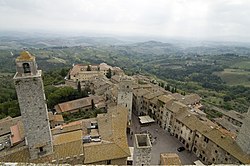San Gimignano
San Gimignano is a small hill town in the province of Siena, Tuscany, Italy. San Gimignano is famous for the medieval towers, and for the wine, called "Vernaccia di San Gimignano".
| Comune di San Gimignano | |
 | |
| Country | Italy |
| Region | Tuscany |
| Province | Siena (SI) |
| Government | |
| • Mayor | Andrea Marrucci ([[List of political parties in Italy|PD]]) |
| Area | |
| • Total | 138 km2 (53 sq mi) |
| Elevation | 324 m (1,063 ft) |
| Population (31 December 2016) | |
| • Total | 7,780 |
| • Density | 56.38/km2 (146.0/sq mi) |
| Time zone | UTC+1 (CET) |
| • Summer (DST) | UTC+2 (CEST) |
| Postal code | 53037 |
| Patron saint | St. Geminianus Saint Fina |
| Website | Official website |
| UNESCO World Heritage Site | |
|---|---|
 | |
| Criteria | Cultural: i, iii, iv |
| Reference | 550 |
| Inscription | 1990 (14th Session) |
| Area | 13.88 ha |
History
San Gimignano was founded as a small village in about 1300 BC by the Etruscans. The city is named after Saint Geminianus, who defended it from Attila the Hun in the mid 5th century.
In medieval and Renaissance times, it was a stopping point for pilgrims on their way to Rome and the Vatican as it sits on the medieval via Francigena.
In 1199, during the period of its highest splendour, the city made itself independent from Volterra.
Important places
There are many churches in the town: the two main ones are the Collegiata, a cathedral, and Sant'Agostino.
The Communal Palace is now the home of San Gimignano Gallery. Hhere there are works by Pinturicchio, Benozzo Gozzoli, Filippino Lippi, Domenico di Michelino, Pier Francesco Fiorentino, and others.
The heart of the town contains the four squares, "Piazza della Cisterna", "Piazza Duomo", "Piazza Pecori", and "Piazza delle Erbe".
Culture
San Gimignano is the birthplace of the poet Folgore da San Gimignano (1270-1332).
Tea with Mussolini, a 1999 drama about English and American women in Italy during World War II, was filmed in part at San Gimignano.
Images
The towers of San Gimignano
San Gimignano
Veiw from the Torre Grossa
San Gimignano Media
The Town Hall (Palazzo Comunale) nearby the Duomo
Via San Giovanni - San Gimignano, Siena, Italy - March 24, 2016 01
Piazza del duomo in san gimignano
San Gimignano, Piazza della Cisterna
References
![]()







